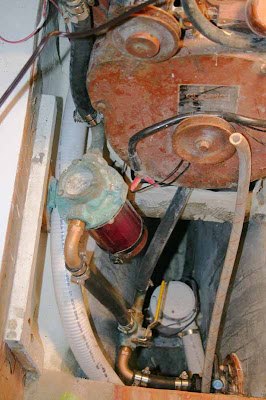
The only productive thing this week was I installed the fuel tank fittings.
I wasn't smart enough to specify exactly what size fittings I needed for the tank when it was built and the sizes were a bit more 'industrial sized' than I would have liked. I guess I should have expected it from a welding shop that builds tanks for the local commercial fishing fleet. I needed to reduced the sizes for the 5/16 inch fuel hose I am using (per Moyer Marine's recomendation- I think 1/4 inch would have been fine too). A problem I had is that the aluminum fittings aren't available and bronze would set up a potential for dissimiliar meta corrosion. I used a stainless reducer on the tank that goes between the aluminum tank and the bronze hose fittings. That brought its own set of probems. The stainless threads, being much tougher, tends to cut into the threads in the aluminum tank making it difficult to tighten sufficiently without destroying the tank fitting. I think I got it but I will have to see how it holds up.
I have a shut-off valve at the tank which should prevent any accidental fuel siphoning disasters. The hose runs to the forward end of the engine where I have a mini 'service center' still under re-construction. The hose will connect with a fuel/water separater, electric fuel pump, final inline fuel filter, second shut-off valve and then the carburetor.
The holidays are almost over and progress will accelerate shortly.
I promise.







